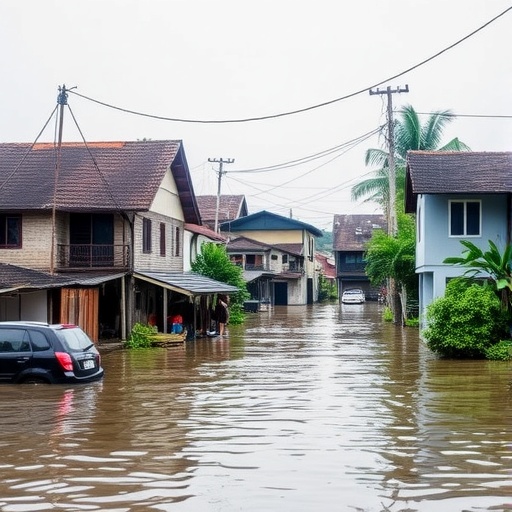
In the rapidly transforming landscapes of the Global South, urban growth is accelerating at an unprecedented pace. Cities swell with a diverse influx of inhabitants seeking livelihood, safety, and opportunity. However, this rapid urbanization brings with it a shadow — an expansion of settlements into high-risk flood-prone areas that places millions at perennial risk of natural disasters. While the physical march of concrete and tin roofs outward is visible, the social and environmental vulnerabilities it engenders are often obscured. A recent in-depth study leveraging cutting-edge machine learning techniques and satellite imagery reveals stark inequalities in flood risk exposure, particularly among the often-overlooked slum populations. These findings shed critical light on how climate hazards intersect with urban poverty in a manner that demands urgent rethinking of urban planning and flood management strategies.
Urbanization in the Global South has long been associated with the growth of informal settlements or slums. These areas typically lack formal recognition and basic infrastructure, yet they serve as home to millions who cannot access adequate housing elsewhere. The nexus of rapid urban growth, climate change, and inadequate governance means that slum locations are frequently dictated by necessity rather than safety. This new research demonstrates that slum dwellers are disproportionately settling within floodplains — low-lying geographic zones known to be vulnerable to inundation during seasonal and extreme flood events. Through precise analysis, the researchers quantify that approximately one in three people living in slums across the Global South is exposed to these hazards.
The integration of advanced machine learning algorithms with high-resolution, publicly available satellite images enabled researchers to identify and map urban slum hot spots with unparalleled accuracy. Traditional census data and ground surveys underreport or entirely miss such informal settlements due to their unofficial status and dynamic nature. By overcoming these barriers, the study unveils spatial patterns and concentrations of vulnerable populations within floodplains that were hitherto poorly understood, unlocking new pathways for data-driven urban resilience planning. This methodological innovation marks a significant development in how environmental risks and social inequities can be assessed with real-time geospatial analysis.
.adsslot_vG0OUMChVk{width:728px !important;height:90px !important;}
@media(max-width:1199px){ .adsslot_vG0OUMChVk{width:468px !important;height:60px !important;}
}
@media(max-width:767px){ .adsslot_vG0OUMChVk{width:320px !important;height:50px !important;}
}
ADVERTISEMENT
Comparative analysis within the study highlights a stark disparity: residents of slums are 32% more likely to reside in floodplains compared to populations in adequate housing. This statistic speaks volumes about environmental injustice manifesting in urban centers, where the poor disproportionately bear the brunt of geophysical hazards. Floodplains, while fertile and ideal for certain infrastructural developments, carry inherent risks that require robust mitigation strategies. However, slum areas nearly universally lack the institutional support and infrastructure necessary to cope with recurrent flooding, setting them on a vicious cycle of exposure and vulnerability.
The researchers also discerned that the prevalence of slum populations within floodplains is markedly higher in regions experiencing recent or recurrent severe flood events. This feedback loop suggests that many displaced or economically marginalized communities are driven toward increasingly hazardous zones due to constrained housing options and land tenure insecurity. Such patterns exacerbate the social vulnerability to climate-induced shocks and compound long-term developmental challenges. Moreover, the geographic congruence between floodplain locations and slum settlements illustrates the spatial dimension of inequality where ecological risk overlays with socio-economic precarity.
This emergent understanding has profound implications for urban governance and disaster risk reduction paradigms. The prevailing emphasis on technological and infrastructural solutions, while necessary, is insufficient without concurrent social equity considerations. The study advocates for flood adaptation policies informed by detailed demographic and spatial data, which prioritize slum populations as key stakeholders. Equitable urban planning must reconcile the trade-offs between economic development, housing affordability, and climate resilience, particularly in rapidly growing cities where land scarcity and informal tenure complicate conventional regulatory approaches.
The use of satellite imagery and machine learning does more than map risk; it opens the door for anticipatory and targeted intervention. Such granular mapping enables governments and humanitarian agencies to identify priority zones for flood defenses, improved drainage systems, and early warning mechanisms. Crucially, it also supports efforts toward social inclusion by making visible those populations frequently marginalized in urban policy discourses. Bridging technical innovation with participatory planning could redefine flood management frameworks that are responsive to both environmental and social realities.
Climate change acts as an accelerant, intensifying the frequency and severity of flood events globally. For slum settlements within floodplains, this means heightened risk profiles that threaten lives, health, and livelihoods. The cyclical nature of flooding also undermines economic stability, as repeated damage erodes household assets and increases vulnerability to poverty traps. The study’s insights into the overlapping geography of slums and flood exposure provide an urgent call for integrating climate adaptation within broader socio-economic resilience strategies, emphasizing prevention over reaction.
It is worth emphasizing that slum dwellers often lack legal land tenure, which compounds their vulnerability. Without secure rights, residents have limited leverage to demand infrastructural investments or participate in urban planning processes. This institutional disenfranchisement makes them even more susceptible to displacement following flood events. The research points to the need for innovative governance models that recognize informal settlements as legitimate urban constituents and actively engage them in co-creating resilient futures.
Historically, urban expansion in many Global South cities has proceeded in a manner disconnected from environmental constraints, driven predominantly by market forces and unplanned migration. This legacy is now catching up as floodplains, previously viewed as marginal or uninhabitable, become central to human habitation out of necessity. Correcting this trajectory requires deploying a multidisciplinary approach involving geoinformatics, social sciences, policy innovation, and community-based action. Only through such holistic efforts can cities hope to transform flood-prone slum areas into safer, more sustainable urban environments.
The research also raises important questions regarding global urban inequality and the intersectionality of climate justice. Urban flooding does not affect all demographics equally; those in impoverished settlements are marginalized not only economically but also ecologically. The disproportionate burden borne by these populations elucidates broader systemic issues related to resource distribution, governance capacity, and international aid priorities. As cities become the central battleground for climate adaptation, addressing these inequities will be vital for global sustainable development goals.
Furthermore, the evolving nature of informal settlements and the lack of consistent data have long hindered comprehensive risk assessments. The application of machine learning to satellite data represents a paradigm shift, creating dynamic, scalable risk profiles visible at city and regional levels. By enabling near real-time monitoring, this analytical framework can support disaster response both before and after flood events, optimizing allocation of scarce resources and enhancing community resilience.
One compelling dimension of the findings is the spatial clustering of slum populations in historically flood-affected zones. These settlements emerge not simply as random aggregates but as communities that often grow in proximity to water bodies, lakes, or river systems. Such locations, while prone to flooding, may offer benefits like informal economic opportunities and access to water. Balancing these factors challenges urban planners to develop nuanced interventions that do not force displacement without alternatives.
In conclusion, the convergence of rapid urbanization, climate variability, and socio-economic marginalization is producing a dangerous paradox. While cities in the Global South are engines of economic hope, their expansion into flood-prone areas exposes millions to hazards that threaten their very survival. The pioneering work combining satellite imagery with machine learning to identify and analyze urban slums within floodplains illuminates this crisis with unprecedented clarity. It underscores the imperative of integrating social justice into urban flood adaptation policies and presents a compelling blueprint for harnessing technological advances in the service of vulnerable communities.
As new waves of urban residents continue to arrive in burgeoning metropolitan hubs across the Global South, the need for inclusive, data-driven, and just flood risk management becomes more urgent than ever. Transforming the outlook for slum populations will require coordinated actions across international agencies, national governments, local authorities, and civil society. Grounded in robust scientific evidence like that presented here, future urban policy must prioritize safety, equity, and sustainability to build cities resilient to the inevitable challenges posed by flooding.
Subject of Research: Vulnerability of slum populations to flood exposure in the Global South using machine learning and satellite imagery.
Article Title: Disproportionate flood exposure for slum populations of the Global South.
Article References:
Li, D., Sun, L., Feng, K. et al. Disproportionate flood exposure for slum populations of the Global South.
Nat Cities (2025). https://doi.org/10.1038/s44284-025-00273-3
Image Credits: AI Generated
Tags: climate change and slumsclimate hazards and urban povertydisaster risk among marginalized communitiesinadequate infrastructure in slumsinformal settlements vulnerabilitymachine learning in urban studiesrapid urban growth challengessatellite imagery flood analysisslum residents flood risk inequalitysocial and environmental vulnerabilitiesurban planning and flood managementurbanization in the Global South



